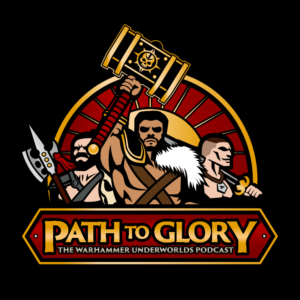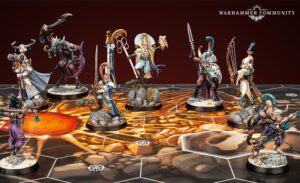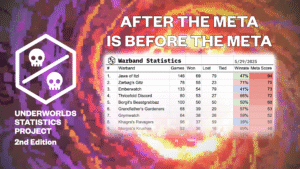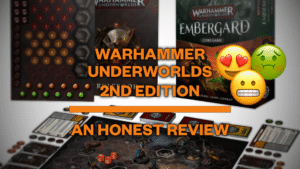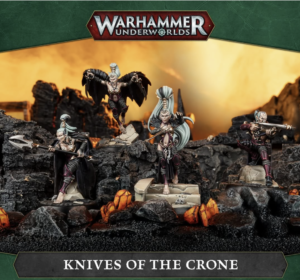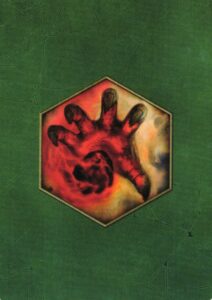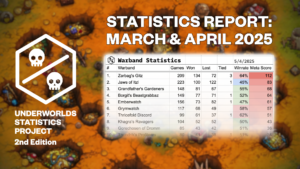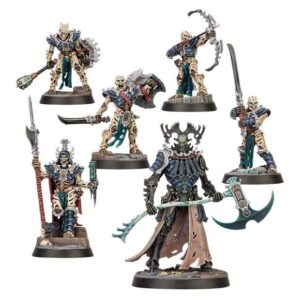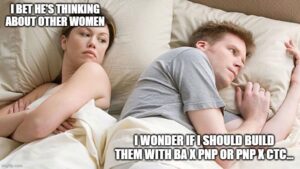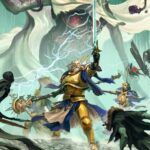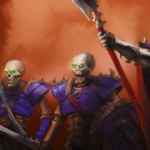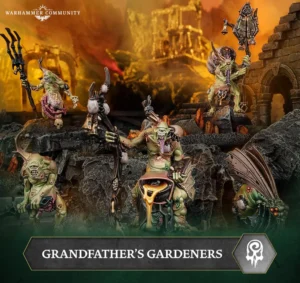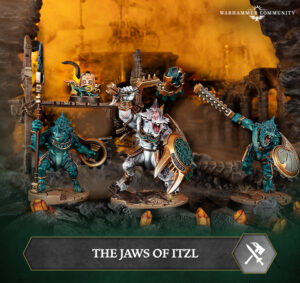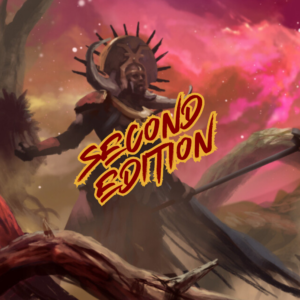After the Vermindoom levelled Embergard, I found myself questing through the ruins of the damned city. After going through tunnel after tunnel, I found myself amongst a number of other fighters in the Underworlds. And I decided to join them on their Path to Glory! Hello, Matt here from Set The Tempo, featured here on Path to Glory. I’m really excited to be able to share my articles, warband and deck reviews, strategy thoughts and event breakdowns here along with the rest of the Path to Glory team. Now, on to the article! -Matt
Welcome to the (re)start of our deck breakdown series here at Set The Tempo! With Embergard coming soon, it’s time to start showcasing and breaking down our decks. This was always one of my favourite series to write as it really helped me dig through each card and give it the full time of day, rather than run past everything and say, gosh it’s just another Sidestep. Also, I love it when I’m wrong and people use the cards I’ve underrated to great effect!

No Fiction Can Deafen The Fact: I Am Nemesis

As one of the main pieces that drew me into Underworlds was the deckbuilding, I’m going to concentrate these articles on the Nemesis format, it being the primary deckbuilding format we’ve got. Now, these card reviews can be used for the deck in its un-altered Rivals format, but synergy of the cards and the overall strength of the deck are what’s more important for that format.
Here’s a breakdown of the three factors I’ll be rating the cards on, updated for the new terminology and edition: Playstyle: Strike, Take & Hold, Flex, Mastery – How do they play? Interactivity: Interactive, Neutral or Passive – How do they play with your opponent? Viability: High, Medium, Low – How much play would I expect the cards to have?
Before I start, I want to say that now that even though we have defined decks that have an associated playstyle that it’s still important that we look objectively at certain cards and define what playstyle they sit in. This is one of the main factors that will help you pick your second deck when you’re looking at what to smash together in the Nemesis format. It may look like a Take & Hold or Flex deck, but those are some nice Strike cards hanging out in there…
The Cards
Objectives



Strike the Head:
- Playstyle: Strike
- Interactivity: Interactive
- Viability: Low
It’s like a more versatile Levelling Strike. I can see this having some decent play in a low wound Strike warband, or where the most smashy fighters are glass cannons, but in general I think most warbands would likely pass on something that is really limiting.
Branching Fate:
- Playstyle: Flex
- Interactivity: Neutral
- Viability: High
I looked back at an old rating I had once given this card (Aggro, Interactive, High), and I’ve realized that I gave that rating based on the fact you had to attack. What you’ll see in some of the ways my thinking has evolved is just realizing that making an attack doesn’t make it Strike or even necessarily Interactive. That’s why I’ve classed this as Flex and Neutral. You do technically need to be in range of another fighter, so you can’t passively score. But this card isn’t even about dealing damage, it’s about roll manipulation. With the new underdog stipulation of allowing this to trigger on two dice, I can see this being played in any build that is using Blazing Assault. Hey, it may be one of the reasons you’re taking the deck in the first place.
Perfect Strike:
- Playstyle: Flex
- Interactivity: Neutral
- Viability: High
Now, I’ll echo most of what I just said on Branching Fate. And where both are looking for specific dice rolls, Perfect Strike is great for attack profiles of 1-2 dice and so has a different arc to how you want to play it. But let’s be honest, if you’re taking this deck as part of your build, you’re likely playing both. And re-rolls.



Critical Effort:
- Playstyle: Flex
- Interactivity: Neutral
- Viability: Medium
Let’s talk probability. On one die, you have a 16.7% chance of rolling a crit. With two, it’s 30.6%. And with three, 42.1%. So, if you’re chucking a lot of dice, this is likely to come up. I’ve got it slightly lower than Perfect Strike because I think it might see less play. But let’s be honest, Strike surges that don’t require a kill are always viable.
Get Stuck In:
- Playstyle: Flex
- Interactivity: Neutral
- Viability: High
Here’s a really strong card for aggressive warbands. Or honestly warbands with ranged attacks. There’s a number of fighter setups that will let you start within range 3 of an enemy fighter. Start game, take a shot, score a glory. Sounds good to me.
Strong Start:
- Playstyle: Strike
- Interactivity: Interactive
- Viability: Medium
I love seeing some old staples return to the game! I think this card is still really potent and would see some play, but in my opinion, if you’re taking Blazing Assault, you’ll likely take the previous four surges I talked about over this. It still has the issue of drawing into it mid-round and it being dead (since a fighter was already taken out of action), or your opponent making the first kill of the round. Which still only allows you the option of one from your secondary deck. I don’t see this making the cut as often as it once did.



Keep Choppin’:
- Playstyle: Strike
- Interactivity: Interactive
- Viability: Medium
I like cards like this. They reward you for sticking to your playstyle. Of course I’m going to attack every activation, I’m here to smash (or hammer now, I guess). Word of caution, this objective seems better than it sometimes ends up being. Sometimes you can’t get in range to attack, sometimes your fighter that needs to attack gets killed and sometimes you’ve already killed everything! Worth trying out, just make sure you have a plan. And definitely better with ranged attacks on board.
Fields of Blood:
- Playstyle: Strike
- Interactivity: Interactive
- Viability: Low
I like these style of objectives as they can be a late game score no matter what your board state is like. That being said, I think this will get stronger down the road if we get a number of gambits that can deal ping damage or if lethal hexes come back. Low damage ranged warbands, especially with a larger number of fighters, are going to play this.
Go All Out:
- Playstyle: Strike
- Interactivity: Interactive
- Viability: Low
At first, this seems pretty decent. Hey, are we playing the game? Of course 5 fighters will have move/charge tokens! Unless fighters start dying. It’s easy to play around and isn’t worth the amount of work for the one glory.



On the Edge:
- Playstyle: Mastery
- Interactivity: Interactive
- Viability: Low
I’ll start with viability. It’s low because it’s hard to guarantee and with that is really hard for one glory. I’ve put it as Mastery as I believe it’s a good example of an alternate scoring pattern that’s based on exactly how you play. Pings, control of damage and results are all needed to make it work. And one crit defense on the defence roll may reduce the damage out of vulnerable range.
Denial:
- Playstyle: Flex
- Interactivity: Interactive
- Viability: Medium
Denial going down to one glory is an interesting decision. I feel like it’s still a very leading card, great for warbands that are striding into enemy territory. But on both sides, will one glory matter? It was always worth it to end in your enemy’s territory to try to deny 2 glory, just in case. Being in a worse position may not be worth one glory but we’ll see.
Annihilation:
- Playstyle: Strike
- Interactivity: Interactive
- Viability: Low
This is a true “win more” card. Yes, it’s nice to get 5 glory for tabling your opponent. But if your game plan involves always killing all your opponents fighters, you’ll either fall short by having one enemy that just won’t die or you’ve probably already won. Skip this one and get some scoring to help you through the game.
Ploys



Determined Effort:
- Playstyle: Strike
- Interactivity: Interactive
- Viability: High
I thought that this was always a solid choice to juice up a must-hit attack. Now that you get a larger benefit when you’re behind, I think it’s an easy way to tilt the game back your way.
Twist the Knife:
- Playstyle: Strike
- Interactivity: Interactive
- Viability: High
The fact that you can boost one damage for an attack, and also set this up so that there isn’t a ton of interaction with other keywords make this a decent card to throw down. It helps outweigh an attack where you’ve got a large dice difference (4 attack vs 1 defence for example) and want to guarantee that extra damage.
Lure of Battle:
- Playstyle: Strike
- Interactivity: Interactive
- Viability: High
As much as this deck does not have Distraction, this can give some of that effect to you. Displacement of an enemy fighter, off treasure maybe, into melee range is a great effect. Yes, it’s got a range restriction so effectively worse than Distraction, but as it’s not limited to an enemy fighter push, it can also be used as a pseudo-Sidestep.



Sidestep:
- Playstyle: Flex
- Interactivity: Passive
- Viability: High
I could likely write a whole article about Sidestep, it’s one of the core ploy cards and has been since Shadespire. Play it and assume your opponent is as well.
Commanding Stride:
- Playstyle: Flex
- Interactivity: Neutral
- Viability: High
This is a card that really can change the board state. A three hex push for your leader, who is normally either your best fighter or a lynchpin part of your strategy, cannot be underestimated. It’s a great stride up the battlefield or a retreat back to safety. The cons on this card are drawing it after your leader is out of action or when the starting hexes are covered. You may not always want it in your deck, but be prepared for your opponent (Mollog, Blackpowder, etc.) to always have it.
Illusory Fighter:
- Playstyle: Flex
- Interactivity: Passive
- Viability: High
I know it’s only November, but Christmas came early. I can’t believe this card is back. Being able to make an early charge, land on a treasure token and teleport back to your territory should not be underestimated. It’s a great way to make an alpha strike, or get back to save your smaller fighters. Think about it like a 10 hex push. Why wouldn’t you take that?


Wings of War:
- Playstyle: Flex
- Interactivity: Neutral
- Viability: High
You’re telling me that Tracking or Spectral Wings are back but it’s as a reaction to declaring the move? I think it’s brilliant. Get to the fighter in the back line, get to that treasure off in the corner, get out of dodge. This is an easy pick.
Shields Up!:
- Playstyle: Flex
- Interactivity: Interactive
- Viability: Medium
Ok, I like this card and also think it’s a bit niche. A free guard token is always good for keeping your position and not being driven back. And gets much better with dodge warbands. I’ve rated it as Flex but honestly, this may be one of the easy cards that Take & Hold warbands will add into their decks.


Scream of Anger:
- Playstyle: Strike
- Interactivity: Passive
- Viability: Medium
Now with charged out rules, having that charge token isn’t necessarily the worst thing late in the game, but the flexibility of being able to make another charge for a fighter is a strong thing to be able to do. Combo it with a warband that wants to take damage, and you’ve got something that could be a surprise behind enemy lines.
Healing Potion:
- Playstyle: Flex
- Interactivity: Passive
- Viability: Medium
So, I’m torn on this one. And it’s Mollog’s fault (a reading one, in fact). I like that it’s no longer contingent on a dice roll; really it’s based off game position now. Heal one is never bad, and at least the largest fighters in the game have to be losing to take full advantage.
Upgrades



Brawler:
- Playstyle: Flex
- Interactivity: Neutral
- Viability: Low
Ignoring supports looks like a nice defensive boost, but how often will it actually come up? You’d have to be up against a swarm and strike warband for it to really make a difference. I don’t mind it from the angle of throwing an agressive charger in the middle of a warband, or a scything fighter spinning around. But I think it’s really situational.
Hidden Aid:
- Playstyle: Flex
- Interactivity: Interactive
- Viability: High
If this card said “Swords are now Hammers on the attack profile” I think it would be playable, and that’s what this somewhat does in a vacuum. Adding a 1/6 potential accuracy (obviously there are counter-plays, positioning or the fact that it does nothing if you already have support) is a strong effect and is a better choice than cleave/ensare due to the attack keywords no longer stacking.
Accurate:
- Playstyle: Strike
- Interactivity: Interactive
- Viability: High
I like the new templating on these effects. But it’s Awakened Weapon, a very strong upgrade and especially since it still costs one glory. The re-roll combos well with some the surge objectives in this deck. I expect this to be at a lot of tables.



Great Strength:
- Playstyle: Strike
- Interactivity: Interactive
- Viability: High
Seeing the change from +1 Damage to Grievous is overall good for the game, in my opinion. It means you can’t just make a giant damage attack to one shot an enemy fighter because you can’t stack these sources. And nullifies your other keywords. I think it helps settle my thought on the next two cards as well.
Deadly Aim:
- Playstyle: Strike
- Interactivity: Interactive
- Viability: Low
I’ll reserve some judgement on this one. Ensnare will be very meta-dependant. You might get a lot of use on it or it may be dead in your hand.
Sharpened Points:
- Playstyle: Strike
- Interactivity: Interactive
- Viability: Low
I’ll reserve some judgement on this one. Cleave will be very meta-dependant. You might get a lot of use on it or it may be dead in your hand. (Whoa, deja-vu!)


Duellist:
- Playstyle: Flex
- Interactivity: Neutral
- Viability: Medium
Having the ability to push after an attack is a really good positional tool that gets better as the game goes on. And for fighters with a range 2 or 3 attack. It means if they’re the only fighter left they can still maneuver the battlefield and attack on every activation. Try to stay out of the initial range of that fighter if you can, as the best strategy is to tempt them to charge.
Tough:
- Playstyle: Flex
- Interactivity: Passive
- Viability: Medium
I both like and and am intimidated by this card. It’s really neat that the limiter is turn, so damage in the power step does not count. The amount of play will be dependant on how many fighters have a very high damage profile (4+) and if those warbands are strong in the meta. Two glory may not always be available to equip this.


Great Fortitude:
- Playstyle: Flex
- Interactivity: Passive
- Viability: Medium
I think it’s really interesting that GW has now made this two glory to equip. The re-roll still costs one glory, but an extra wound and other defensive cards (like Tough) being more expensive than the past really does signal that the emphasis is away from passive defensiveness. I still expect this to see decent play, but may not be the first upgrade on your fighter (and makes an extremely interesting choice when you only have one glory; do you wait for the second score or equip something for one?).
Keen Eye:
- Playstyle: Strike
- Interactivity: Interactive
- Viability: High
Giving range 1-2 weapons an extra attack dice is always a very strong upgrade; this will make a decent accuracy boost. Even with the extra glory cost, this is an easy include for Strike decks, especially ones that are playing with Critical Effort. Just remember that extra dice make Branching Fate harder!
Conclusion
I think as a core box deck to exemplify the Strike playstyle, Blazing Assault succeeds wholeheartedly. Obviously, we have yet to see what other Strike decks fully look like, but I believe that this deck is full of a lot of staples that both pure Strike focus would want and cards that other builds would want to splash. Now, I’ll also say that it’s pretty basic and I can’t wait to see where the design space goes in future decks.
Thanks again for reading. What are your thoughts on Blazing Assault? Card ratings you disagree with? If you have any questions or comments, I’m on the Discords as Matt ~ Set The Tempo, or reach out to me at setthetempoblog@gmail.com. Take care and be well!
